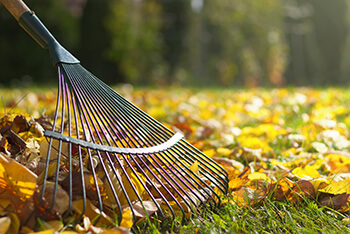Plan for fall lawn care now
Sep 23, 2019

Dawn Matlock, TFC Turf and Ornamental Coordinator
Fall lawn care might be the last thing on your mind during this scorching hot weather, but planning your to-do list for those fall chores now will give you a head start on a healthy lawn next spring.
Here are four fall lawn care tips to get you started:
Keep up the basics.
Continue mowing and watering your lawn as needed. Dethatching your lawn is crucial for adequate air flow to grass roots. Also, fall is an ideal time to aerate your lawn, which allows oxygen, water, and fertilizer to easily reach the grass’s roots. If you don’t have an aerator, contact your local Co-op; many stores have them available for sale or rent. Take time to remove any leaves, especially wet ones, from the lawn and flowerbeds to avoid suffocating the grass and breeding fungal diseases.
Consider a fall application of fertilizer.
Even though grass’s growth decreases in cooler temperatures, the grass roots and rhizomes continue to grow quickly. A fall application of fertilizer will deliver essential nutrients for the root growth and store nutrients for a healthy start next spring. Your local Co-op store has a variety of fertilizers, and employees can help you find the one that will fit your lawn’s specific needs. The Tenn-Lawn 21-8-12 Slow-Release with Iron (#98455) fertilizer is a good option. Fall is also a good time to take soil samples if you’d like specific recommendations for your lawn’s nutrient needs.
Fall is the best time of year to overseed your lawn.
The ideal germination temperature for cool-season turfgrass is from 60 to 85 degrees. First Choice Tall Fescue (#180520) blend will create a beautiful lawn with fine blades of deep, dark green. It also has excellent wear resistance and lower maintenance requirements compared to other turfgrasses. The Tenn-Lawn 15-20-10 Aeration Special Starter fertilizer (#98454) is ideal when starting or renovating your lawn.
Apply a pre-emergent herbicide.
Remember last spring when chickweed and henbit showed their ugly heads in your yard? These winter annual weeds begin lurking in your lawn in early fall, just waiting to grow. That’s why an application of a pre-emergent herbicide in the fall is vital to weed control in the spring. However, the timing is imperative to ensure the effectiveness of the chemical. The most common chemicals used on home lawns for most broadleaves and annual grasses are Dimension or Barricade. Please keep in mind that these cannot be used when overseeding since most pre-emergents for weeds will also prevent grass seed from germinating.
Planning for your fall lawn care now is the first step to a beautiful lawn next spring. For more advice about lawn care tips and products, contact the knowledgeable, friendly staff at your local Co-op.
Fall lawn care might be the last thing on your mind during this scorching hot weather, but planning your to-do list for those fall chores now will give you a head start on a healthy lawn next spring.
Here are four fall lawn care tips to get you started:
Keep up the basics.
Continue mowing and watering your lawn as needed. Dethatching your lawn is crucial for adequate air flow to grass roots. Also, fall is an ideal time to aerate your lawn, which allows oxygen, water, and fertilizer to easily reach the grass’s roots. If you don’t have an aerator, contact your local Co-op; many stores have them available for sale or rent. Take time to remove any leaves, especially wet ones, from the lawn and flowerbeds to avoid suffocating the grass and breeding fungal diseases.
Consider a fall application of fertilizer.
Even though grass’s growth decreases in cooler temperatures, the grass roots and rhizomes continue to grow quickly. A fall application of fertilizer will deliver essential nutrients for the root growth and store nutrients for a healthy start next spring. Your local Co-op store has a variety of fertilizers, and employees can help you find the one that will fit your lawn’s specific needs. The Tenn-Lawn 21-8-12 Slow-Release with Iron (#98455) fertilizer is a good option. Fall is also a good time to take soil samples if you’d like specific recommendations for your lawn’s nutrient needs.
Fall is the best time of year to overseed your lawn.
The ideal germination temperature for cool-season turfgrass is from 60 to 85 degrees. First Choice Tall Fescue (#180520) blend will create a beautiful lawn with fine blades of deep, dark green. It also has excellent wear resistance and lower maintenance requirements compared to other turfgrasses. The Tenn-Lawn 15-20-10 Aeration Special Starter fertilizer (#98454) is ideal when starting or renovating your lawn.
Apply a pre-emergent herbicide.
Remember last spring when chickweed and henbit showed their ugly heads in your yard? These winter annual weeds begin lurking in your lawn in early fall, just waiting to grow. That’s why an application of a pre-emergent herbicide in the fall is vital to weed control in the spring. However, the timing is imperative to ensure the effectiveness of the chemical. The most common chemicals used on home lawns for most broadleaves and annual grasses are Dimension or Barricade. Please keep in mind that these cannot be used when overseeding since most pre-emergents for weeds will also prevent grass seed from germinating.
Planning for your fall lawn care now is the first step to a beautiful lawn next spring. For more advice about lawn care tips and products, contact the knowledgeable, friendly staff at your local Co-op.